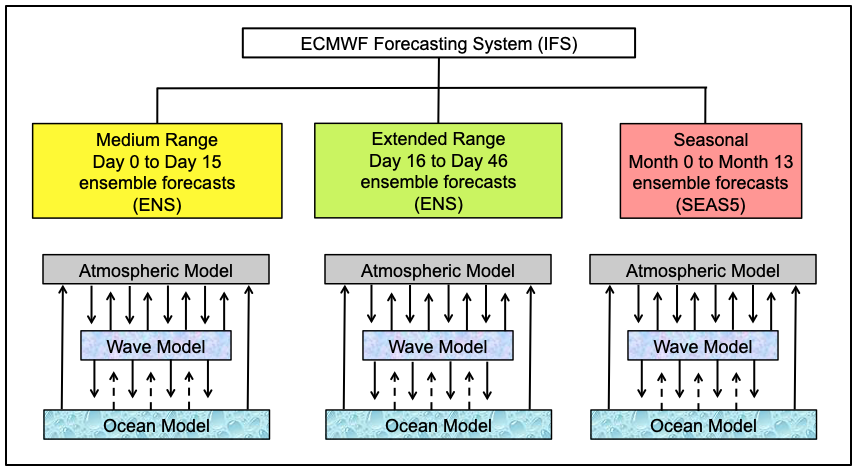Page History
...
These are outlined in Fig2.-1, Fig 2.-2 and Fig2.-3. The The models and programs run co-operatively to produce forecasts from analysis time out to days, weeks or months ahead.
Fig2.-1: ECMWF Integrated Forecasting System (IFS) Illustrates interactions between components of the IFS (observation assimilation and post-processing not shown)
Fig2.-2: Exchange of physical quantities between the atmospheric, ocean wave and ocean models. All All the models exchange information and additionally the Wave model gains from the Ice model information on ice cover.
...
- to the Atmospheric model, information on:
- ice cover.
- to the Wave model, information on:
- ice cover.
...
- the ocean is the lower boundary for the atmosphere for a large part of the earth.
- the lower boundary gives important feedback to the atmosphere if accurately modelled (especially important for long-range predictions like monthly or seasonal forecasting and for features such as El Nino-Southern Oscillation, ENSO).
- the ocean state (including sea‐ice) can change on a daily timescale and these variations can be important in certain situations during the forecast evolution. Important Important impacts of the modelled state of the ocean upon the evolution include:
- drag from the waves on the atmosphere (can help prevent over-deepening of lows as bigger waves impart more drag),
- ice variations and extent (gives more information on boundary temperatures, can hinder the propagation of ocean waves, reduced drag over ice sheets can allow increased winds),
- storm or hurricane feed back to or from the ocean (potential for upwelling of colder water induced by passage of a major storm or depression over a temperature-stratified ocean).
...
- the land is the lower boundary for the atmosphere for a less extensive area than the sea but it has a complex orography and exhibits far more temporal and spatial variability in the characteristics of energy storage and exchange.
- the lower boundary gives important feedback to the atmosphere if accurately modelled (important for short and long-range forecasting).
- the state of the landmasses (including soil moisture, cover and depth of snow, and lake ice) can change on a daily timescale and these variations can be important in certain situations during the forecast evolution. Important aspects Important aspects of the modelled state of the land that can affect the atmospheric evolution include:
- rainfall absorption and soil moisture (give more information on boundary moisture flux),
- ice variations on lakes (gives more information on albedo and boundary heat and moisture fluxes),
- land/lake temperature variations for evaluation of heat fluxes,
- snow variations and extent (gives more information on albedo and boundary heat and moisture fluxes).
...
- the ENS and HRES forecast (Day0 to Day10) twice daily based on 00UTC and 12UTC data.
- the ENS forecast (Day0 to Day15) twice daily based on 00UTC and 12UTC data.
- the Extended Range forecast (Day0 to Day46) once daily based on 00UTC data.
- the Seasonal forecast (Month0 to Month7 once each month, Month0 to Month13 once each quarter) on first day of the month based on 00UTC data.
More information is given within the Users Guide on the structures of the Global Atmospheric Model, the Ocean Wave Model, and the Dynamic Ocean Model and regarding the resolution of the models currently used within the IFS.
Real-time forecasts are initialized from the operational analysis using 4D-Var. Re-forecasts are initialized from ERA5, except for soil initial conditions (soil temperature, soil moisture, snow initial conditions) which are provided by an offline soil reanalysis. Oceanic Oceanic models are initialized from the real-time suite, NEMOVAR.
...


